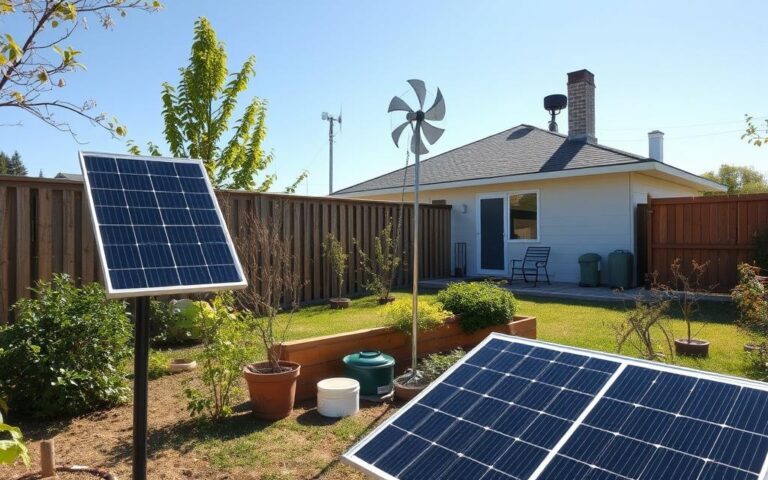
70% of the U.S. power grid is over 25 years old. This creates an urgent need for smart grid technology. These systems are crucial for managing energy sustainably as demands grow.
Smart grid technology revolutionizes power distribution. It adds digital communication and monitoring to traditional electrical networks. This allows real-time tracking and efficient energy routing.
Smart grids aim to create responsive and eco-friendly power systems. They use advanced sensors and analytics to reduce waste. These networks optimize power distribution across complex electrical systems.
U.S. utilities are quickly adopting smart grid solutions. They address aging infrastructure and integrate renewable energy sources. This tech improves grid reliability and energy sustainability.
Smart grids are reshaping our approach to energy. They impact how we produce, distribute, and use power. This technology promises significant improvements in efficiency and conservation.
Understanding Smart Grid Technology: A Comprehensive Overview
Smart grid technology transforms electrical power distribution with intelligent systems. It revolutionizes how we generate, transmit, and consume electricity. Advanced metering infrastructure modernizes our national power networks, creating efficient energy management solutions.

Power grids have evolved from one-way communication systems to sophisticated, interconnected networks. Grid modernization focuses on developing robust technological capabilities. These capabilities enhance reliability, efficiency, and sustainability.
Core Components of Modern Smart Grids
Modern smart grids integrate several key technological elements:
- Smart meters for real-time energy consumption tracking
- Advanced communication networks
- Automated control systems
- Sensor technologies for predictive maintenance
Technological Transformation
The shift to smart grid technology involves significant technological upgrades. Intelligent infrastructure enables two-way communication between utility providers and consumers. This allows for more dynamic and responsive energy management.
Key Technical Capabilities
Smart grid technology offers unprecedented capabilities in energy distribution:
- Real-time energy consumption monitoring
- Rapid fault detection and isolation
- Enhanced integration of renewable energy sources
- Improved grid stability and resilience
Smart grids leverage cutting-edge digital technologies to reshape energy infrastructure. They provide sustainable and efficient power distribution solutions for communities across the United States.
The Environmental Impact of Smart Grid Implementation
Smart grid technology is a game-changer for reducing carbon footprints and managing energy sustainably. These intelligent power networks use advanced digital communication to boost energy efficiency across electrical systems.
Smart grids offer major environmental benefits. They cut greenhouse gas emissions and integrate renewable energy better. They also allow real-time energy monitoring and optimize power distribution.
- Significant reduction in greenhouse gas emissions
- Enhanced renewable energy integration
- Real-time energy consumption monitoring
- Optimized power distribution
Smart grids track energy use precisely, helping utilities and consumers make smarter choices. This data-driven approach directly supports carbon footprint reduction strategies. It spots inefficiencies and promotes sustainable practices.
Numbers show how smart grids can transform our energy use:
| Environmental Metric | Potential Reduction |
|---|---|
| Greenhouse Gas Emissions | Up to 20% by 2030 |
| Energy Waste | Approximately 15-25% |
| Carbon Footprint | Estimated 10-18% decrease |
Smart grids balance electricity supply and demand dynamically. This creates a more resilient and eco-friendly energy system. Their ability to integrate renewable energy sources boosts global sustainability efforts.
Integration of Renewable Energy Sources Through Smart Grids
Smart grids are changing how we use renewable energy. These advanced networks manage solar, wind, and energy storage solutions. They create intelligent connections between various energy sources, transforming sustainable power generation.
The renewable energy integration process uses several key strategies. These enable smooth power distribution and management.
- Real-time monitoring of energy production and consumption
- Dynamic load balancing across multiple power sources
- Intelligent routing of electricity from renewable sources
- Predictive maintenance and performance optimization
Solar Power Integration Mechanisms
Solar power integration uses advanced inverter technologies and grid synchronization. Smart grids use sophisticated algorithms to manage changing solar energy generation. This ensures stable power during variable sunlight conditions.
Photovoltaic systems now have smart monitoring systems. These can quickly adjust power output based on grid needs.
Wind Energy Management Systems
Smart grid technologies have made wind energy management more efficient. Intelligent control systems can predict wind patterns and optimize turbine performance. They also smoothly integrate wind-generated electricity into the power grid.
These systems help address the challenges of wind energy’s variability.
Energy Storage Solutions
Energy storage is crucial for renewable energy integration. Smart grids use advanced battery technologies and distributed storage systems.
- Store excess renewable energy during peak production
- Provide backup power during low generation periods
- Stabilize grid voltage and frequency
- Reduce overall energy transmission losses
Smart grid technologies are key to a sustainable power future. They will create a more resilient energy infrastructure as renewable sources grow.
Smart Grid Technology: Economic Benefits and Cost Savings
Smart grid technology is transforming the energy sector with significant economic advantages. It offers cost savings for utility companies and consumers. Advanced grid management strategies optimize power distribution and consumption, making energy cost reduction a reality.
Smart grid systems boost operational efficiency through intelligent technologies. Utilities can now monitor and control power networks with unprecedented precision. This reduces waste and minimizes operational expenses.
- Reduce energy consumption by up to 15%
- Lower infrastructure maintenance costs
- Enable real-time energy pricing
- Minimize power outage durations
Demand response programs are a key innovation in smart grid technology. These systems allow users to adjust energy usage during peak hours. This creates significant cost savings and supports grid stability.
| Economic Benefit | Potential Savings | Impact Area |
|---|---|---|
| Consumer Energy Costs | 10-25% | Residential |
| Utility Operational Expenses | 15-30% | Infrastructure |
| Grid Efficiency | 20% | Power Distribution |
Smart grid technologies unlock economic potential while supporting sustainable energy practices. The future of energy management lies in intelligent, responsive systems that balance cost-effectiveness with environmental responsibility.
Cybersecurity Challenges in Smart Grid Infrastructure
Smart grids are complex networks of digital technologies that need strong cybersecurity strategies. As power systems become more connected, grid security is now crucial for utilities and national security experts.
Protecting energy infrastructure requires multiple layers of threat detection and data protection. Cyber attacks can disrupt essential services and compromise sensitive information, posing significant risks to national power systems.
Threat Detection Systems
Advanced threat detection systems are vital for identifying and stopping security breaches. These technologies use sophisticated tools to keep grids safe.
- Real-time network monitoring
- Anomaly detection algorithms
- Machine learning-powered security analytics
- Predictive risk assessment tools
Data Protection Protocols
Robust data protection protocols safeguard sensitive grid information. Key strategies help maintain the integrity of smart grid systems.
- Encryption of communication channels
- Multi-factor authentication systems
- Regular security audits
- Comprehensive access control mechanisms
Security Standards and Compliance
Critical security standards guide grid cybersecurity practices. The table below highlights important standards in the field.
| Standard | Focus Area | Key Requirements |
|---|---|---|
| NERC CIP | Critical Infrastructure Protection | Comprehensive security management controls |
| NIST Framework | Cybersecurity Risk Management | Identify, protect, detect, respond, recover |
| ISO 27001 | Information Security Management | Systematic approach to data protection |
“Cybersecurity is not just a technical challenge, but a critical infrastructure protection imperative.” – Cybersecurity Expert
Continuous innovation and vigilance are paramount in addressing the evolving landscape of grid cybersecurity threats.
Consumer Engagement and Smart Meter Benefits
Smart meter technology has changed how we use energy. These devices give real-time insights into household energy use. They help people make better choices about their electricity consumption.
The main benefits of smart meter technology include:
- Detailed energy consumption monitoring
- Real-time usage tracking
- Potential cost savings
- Enhanced consumer empowerment
Utility companies now offer dynamic pricing based on smart meter data. People can understand their energy patterns better. They can adjust their usage during peak and off-peak hours.
This can help reduce monthly electricity bills. Consumers now have more control over their energy costs.
| Smart Meter Feature | Consumer Benefit |
|---|---|
| Real-time Energy Tracking | Immediate usage insights |
| Dynamic Pricing | Lower electricity costs |
| Detailed Consumption Reports | Better energy management |
Smart meters help households spot inefficient appliances. They also promote more sustainable energy habits. By understanding their precise energy usage, people can make smarter choices.
These choices can benefit both their wallet and the environment. Smart meters are a tool for active energy management.
“Smart meters transform consumers from passive recipients to active managers of their energy consumption.” – Energy Innovation Center
Smart Grid Policy and Regulatory Framework
Smart grid technology is reshaping energy policy. Governments are creating frameworks to support grid modernization and tech integration. These initiatives span federal, state, and international levels.
Implementing advanced energy infrastructure requires strategic planning. Regulatory compliance drives innovation and standardization across jurisdictions. It’s crucial for smart grid development.
Federal Guidelines and Standards
The U.S. government has set key frameworks for smart grid implementation. These include:
- Energy Independence and Security Act of 2007
- Federal Energy Regulatory Commission (FERC) guidelines
- Department of Energy smart grid investment programs
State-Level Implementation Programs
States are creating unique grid modernization strategies. These address local energy needs effectively.
| State | Key Smart Grid Initiative | Primary Focus |
|---|---|---|
| California | Grid Resilience Program | Renewable Energy Integration |
| New York | Reforming Energy Vision (REV) | Distributed Energy Resources |
| Texas | Advanced Metering Systems | Grid Efficiency |
International Cooperation Initiatives
“Collaborative approaches are essential to advancing global smart grid technologies and addressing climate challenges.” – International Energy Agency
Global partnerships drive innovation in energy policy. Key international collaborations focus on:
- Standardization of smart grid technologies
- Cross-border energy research programs
- Shared cybersecurity protocols
Modern energy systems need comprehensive regulatory frameworks. These must balance innovation with reliability and security. The interconnected nature of energy demands this approach.
Future Innovations in Smart Grid Development
Grid innovation is changing fast, powered by new technologies that will transform energy management. AI and IoT are leading the charge. They’re making smart grids more efficient and intelligent than ever before.
Key innovations are reshaping electrical networks:
- Advanced AI-powered predictive maintenance systems
- Real-time grid monitoring through IoT sensors
- Dynamic load balancing technologies
- Decentralized energy distribution networks
AI is crucial for optimizing grid performance. It can predict energy use, spot potential failures, and adjust distribution networks. This makes grids more reliable and cheaper to run.
IoT is changing smart grid infrastructure. Connected devices allow seamless communication between grid parts. This creates a more responsive energy ecosystem.
Smart meters, sensors, and automated controls offer new insights into energy use. They help us see how power is consumed and distributed like never before.
“The future of energy management lies in intelligent, interconnected systems that can adapt in real-time to changing demands and conditions.” – Energy Innovation Research Institute
New tech is set to unlock fresh possibilities in grid innovation. It’s making energy systems more sustainable, efficient, and resilient. The future of smart grids looks brighter than ever.
Case Studies: Successful Smart Grid Implementations
Smart grid projects have revolutionized utility infrastructure in the United States. They offer innovative solutions to complex energy issues. Several utility companies lead the way in grid modernization.
Portland General Electric shines in the Pacific Northwest. They implemented advanced metering and real-time monitoring systems. As a result, power outages dropped by 35%, and energy efficiency improved significantly.
- Reduced operational costs through advanced technologies
- Enhanced grid reliability and resilience
- Improved customer engagement and energy management
Austin Energy in Texas also stands out. They developed a smart grid system that integrates renewable energy sources. This innovative approach maintains grid stability while using clean energy.
- Advanced distributed energy resource management
- Real-time demand response capabilities
- Comprehensive cybersecurity protocols
| Utility Company | Smart Grid Innovation | Key Outcome |
|---|---|---|
| Portland General Electric | Advanced Metering Infrastructure | 35% Reduction in Power Outages |
| Austin Energy | Renewable Energy Integration | Enhanced Grid Stability |
These case studies show how smart grid technologies can create efficient, reliable, and sustainable energy systems.
Conclusion: The Path Forward for Smart Grid Technology
Smart grid technology is transforming our energy future. It offers solutions for complex power systems. This technology provides opportunities for sustainable power distribution.
Grid transformation goes beyond technological upgrades. It’s about rethinking electricity generation, transmission, and consumption. U.S. utilities see its potential for enhancing reliability and reducing emissions.
Smart grids integrate renewable energy and advanced analytics. They offer real-time monitoring capabilities. These features make them crucial for future energy strategies.
Smart grid technology will address global energy challenges. Investments in research and infrastructure will drive new power systems. Collaboration between government, private sector, and academia is essential.
Embracing smart grids is necessary for efficient energy infrastructure. It lays the groundwork for a sustainable future. This connected power grid will create a more resilient energy ecosystem.
FAQ
What exactly is a smart grid?
A smart grid is an advanced electrical grid system. It uses digital tech to manage electricity distribution more efficiently. The system allows two-way communication between utility providers and consumers.
This enables real-time data exchange and improves reliability. It also helps integrate renewable energy sources better.
How do smart grids improve energy efficiency?
Smart grids provide real-time monitoring of energy use. They enable dynamic pricing and reduce transmission losses. These grids also help manage peak demand periods better.
Consumers and utilities can make smarter choices about energy use. This leads to improved overall efficiency.
Are smart meters part of smart grid technology?
Yes, smart meters are key to smart grid technology. They give real-time energy use data to consumers and utilities. This allows for precise tracking of electricity usage.
Smart meters help identify ways to save energy. They also enable more accurate billing.
How do smart grids support renewable energy integration?
Smart grids manage the changing nature of solar and wind power. They use complex algorithms to balance supply and demand. Energy storage solutions help ensure a stable power supply.
What cybersecurity measures protect smart grid infrastructure?
Smart grid security uses many layers of protection. These include advanced threat detection and encrypted communication. Regular security checks and strong data protection are also used.
The system follows federal cybersecurity rules. This helps prevent cyber attacks and protects critical infrastructure.
What are the economic benefits of smart grid technology?
Smart grids cut costs for utility companies and consumers. They allow for dynamic pricing and lower maintenance costs. The tech also creates new jobs in the advanced energy sector.
How do smart grids contribute to environmental sustainability?
Smart grids help integrate more renewable energy sources. They reduce carbon emissions and minimize energy waste. The grids improve overall efficiency and support a low-carbon energy system.
What federal policies support smart grid development?
The Energy Independence and Security Act of 2007 supports grid modernization. It provides guidelines and funding. The Department of Energy also promotes research and development of advanced grid tech.
Can smart grids help during power outages?
Smart grids improve outage management with advanced monitoring systems. They quickly detect and isolate power disruptions. The grids can reroute electricity and restore services faster than traditional systems.
What future innovations are expected in smart grid technology?
Future smart grids will use more artificial intelligence. They’ll have advanced Internet of Things devices. Improved predictive maintenance and energy storage are also expected.
More sophisticated demand response systems will be developed. These innovations will make grids even smarter and more efficient.



